Key Insights
- Average daily new addresses increased 106% QoQ to 19,300, with average daily active addresses increasing 3% QoQ to 45,300. New dApps like Estfor Kingdom helped spur this growth.
- The first distribution of quarterly bonuses from the Gas Monetization program occurred in August, with over 500,000 FTM going to 12 different protocols. In addition, 750,000 FTM will be distributed from the Ecosystem Vault in early Q4’23.
- The Fantom Foundation launched its Fantom Sonic testnet along with some initial data. The public testnet for Sonic Fantom launched on October 24, 2023 and includes a new virtual machine, new database storage, and an optimized Lachesis consensus mechanism.
- DeFi TVL decreased 69% QoQ to $75 million. The drop mostly occurred from the Multichain incident in July.
Primer on Fantom
Launched in 2018, Fantom is a Layer-1 protocol focused on fast and cost-efficient transaction execution. Fantom became a DeFi hub with development help from Andre Cronje. As a result, Fantom’s network hosts dozens of DeFi protocols, including Curve, Yearn, and SushiSwap. In addition to DeFi, Fantom also supports NFTs and games, like the new Estfor Kingdom.
Fantom uses a Proof-of-Stake consensus mechanism called Lachesis, which was created by the Fantom Foundation. Lachesis provides security to Fantom’s EVM-compatible smart contract chain. Because Fantom nodes reach consensus independently, each node verifies transactions asynchronously and is not required to incorporate other blocks sequentially. This speeds up transaction execution.
FTM, the project’s native token, is used for payments and governance. It also enables ongoing block rewards for validators and delegators who stake FTM. Fantom validators must stake a minimum of 50,000 FTM.
Key Metrics
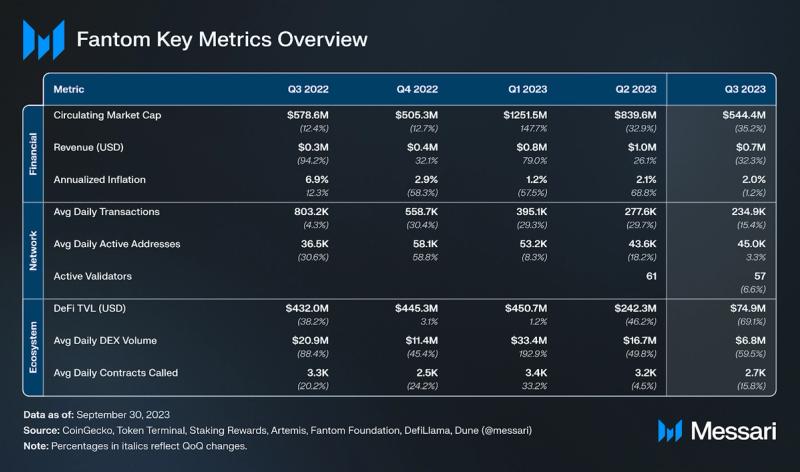
Financial Overview
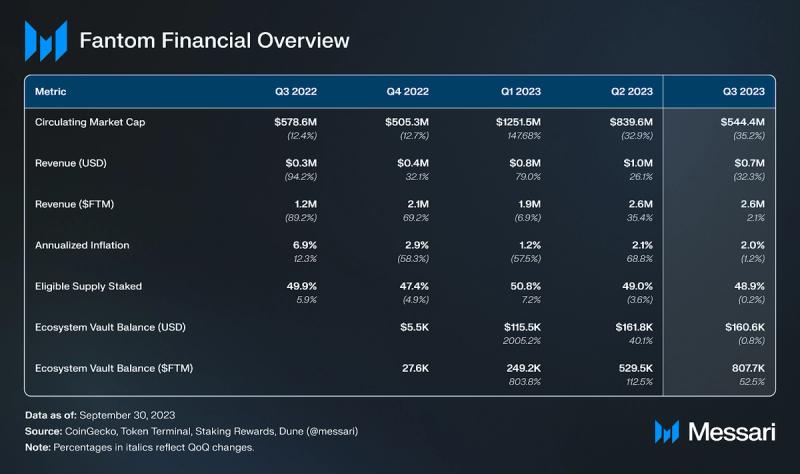
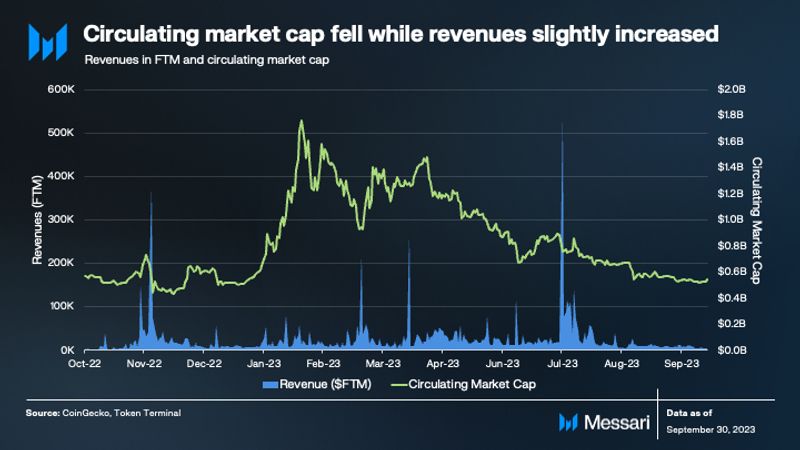
Q3’23 featured a largely quiet and sideways-trading crypto market. The one major exception was a large selloff in mid-August. FTM followed this trend: its circulating market cap decreased 35% QoQ to $544 million, with a 15% drop occurring from August 16-18. Additionally, the Multichain incident caused a drop in FTM from July 5-7. The Multichain incident in early July also caused a spike in activity on Fantom, which helped drive up quarterly revenue in FTM 2% QoQ to 2.6 million FTM. Once the dust settled, FTM’s market cap rank among all tokens fell QoQ from 47 to 63.On July 6, 2023, Peckshield reported a potential exploit of the Multichain: Fantom Bridge, highlighting outbound transfers of 7,214 WETH (13.6 million), 1,023.8 WBTC (31 million), and 57.8 million USDC. The Multichain team confirmed that these were unauthorized transactions and advised all users to stop using Multichain services. In response to the Multichain incident, the Fantom Foundation stated the following on September 29, 2023:
“An update on our work to identify affected assets within the Fantom community as a result of the July 6 Mulitichain exploit. Fantom Foundation has engaged leading blockchain intelligence firm, TRM Labs, to conduct an independent investigation and accelerate our ability to trace and recover funds for Fantom users. We continue to do everything we can to resolve this matter. We’d like to sincerely thank our community for their continued support.”
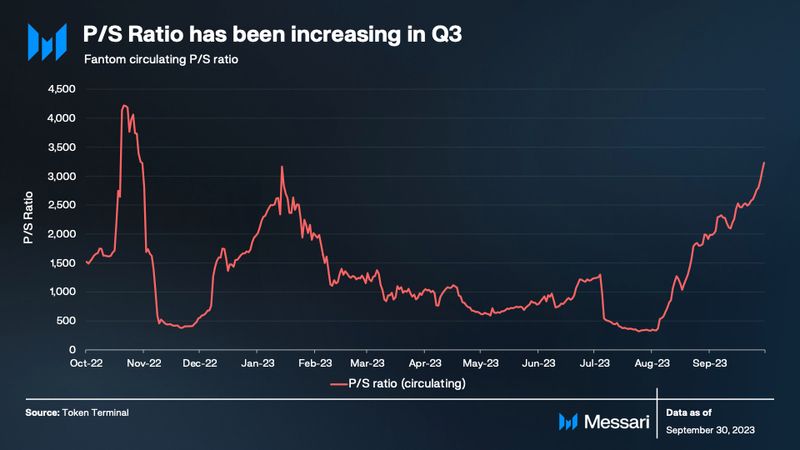
After the initial spike from the Multichain incident, quarterly revenues decreased in the second half of Q3’23, as evidenced by the increasing circulating P/S ratio. While a P/S ratio may provide directional insight into fundamental value accrual versus speculative market behavior, it is not necessarily adequate for evaluating blockchain assets. Other valuation techniques have also been introduced, including Messari’s Expected Demand for Security Model and Multicoin’s Sum of the Parts framework.The circulating supply of FTM was essentially flat QoQ after supply dynamics changed between Q4’22 and Q1’23. During Q4’22, Fantom’s Ecosystem Vault and Gas Monetization program were introduced (more details in the Ecosystem section). They reduced the burn rate of transaction fees from 30% to 5%, with the 25% reallocated to the Gas Monetization program and Ecosystem Vault. At the same time, validator rewards remained constant. Proposal 23 was passed in Q1’23 and reduced inflationary validator rewards from 14% to 6%. As such, inflationary staking rewards are projected to last until 2028. Additionally, by September 30, 2023, over 10.5 million FTM (0.3% of its 3.175 billion supply) has been burned. Lastly, the staking ratio (the proportion of Fantom’s total supply actively being staked) essentially remained flat as it decreased only 0.2% QoQ to 49%. This metric’s stability implies that many of Fantom’s stakers remained committed despite the issues from the Multichain incident.
Network Overview
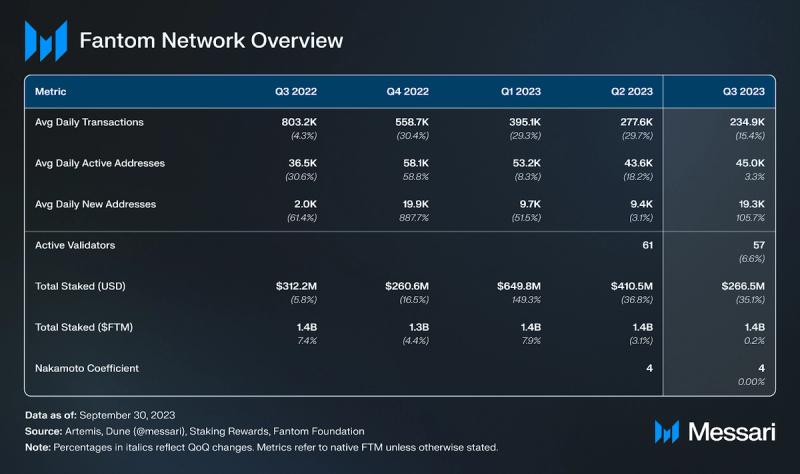
Usage
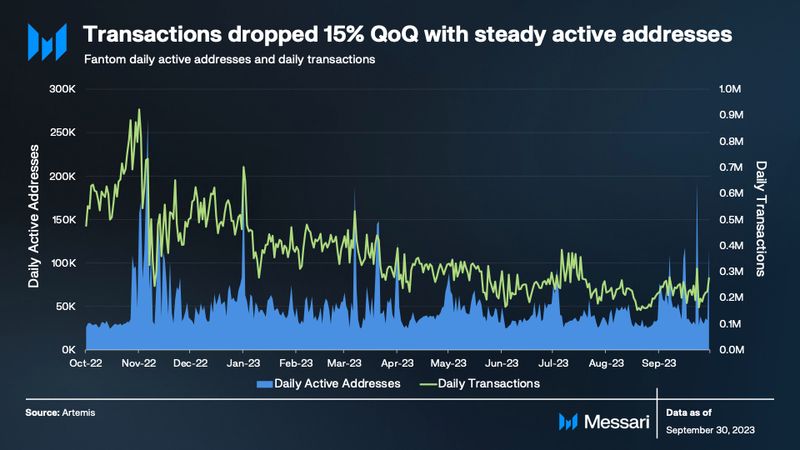
In Q3’23, Fantom had 45,000 daily active addresses, up 3% QoQ. This marginal increase is in line with the long-term yearly average for daily active addresses of 48,000.
As for average daily transactions, its declining trend continued in Q3’23, down 15% QoQ to 235,000. A large reason for this fall-off was due to a decrease in transactions from LayerZero. LayerZero found traction after LayerZero Labs developed Stargate, a bridge built on top of LayerZero. According to DappRadar, during the week of July 1-7, the daily active transaction average on Stargate for Fantom was 179,000. By the last week of Q3’23, the daily active transaction average was down to 71,000, a decrease of 60%. To put this into perspective, Stargate transactions represented 64% of all transactions on Fantom during the first week of July but only 34% of all transactions during the last week of September. Notably, the initial increased activity related to Stargate has been prevalent across multiple networks, most likely driven by airdrop farming.
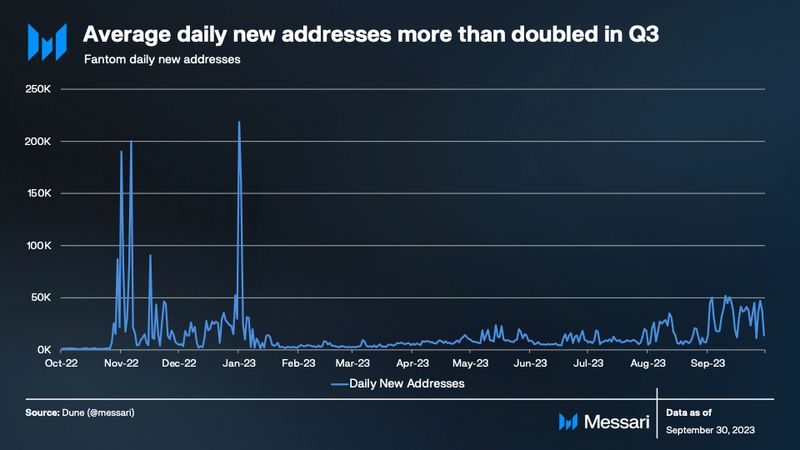
Daily new addresses increased QoQ for the first time in 2023, up 106% to 19,300. The majority of this increase occurred in the month of September. The increase in daily new addresses coincides with the late-August launch of Estfor Kingdom, a blockchain-based game on Fantom. According to DappRadar, Estfor Kingdom hit a peak of 16,500 unique users on September 4, 2023. On the same day, there were 31,000 new addresses on Fantom. While Estfor Kingdom helped drive growth, there were likely other factors as well.
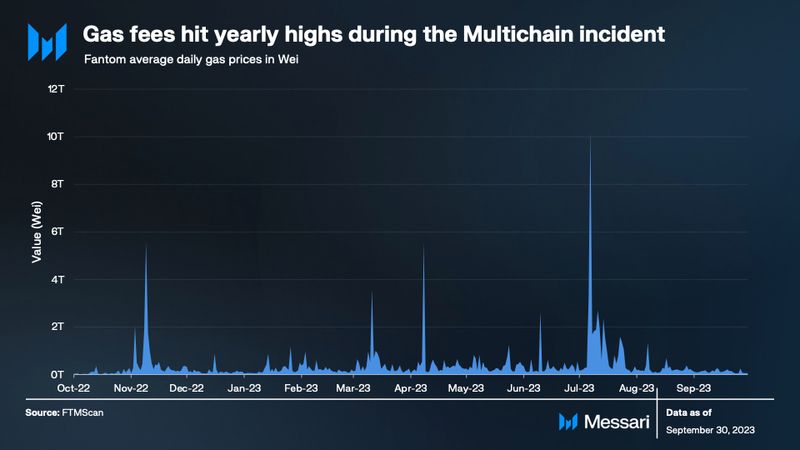
Gas fees spiked to all-time highs in Q3’23 as a result of the Multichain incident in early July. Previously, the all-time high gas fee occurred on May 11, 2022, during the collapse of LUNA/Terra, when the average gas price hit 9,650 Gwei. That record was broken on July 7, 2023, when the average gas price reached 10,200 Gwei. Gas prices remained elevated for the whole month of July before returning to historical averages in August.
Security and Decentralization
Fantom uses a Proof-of-Stake consensus mechanism called Lachesis. It provides security to Fantom’s EVM-compatible smart contract chain, Opera.
Fantom nodes reach consensus independently. Because each node verifies transactions asynchronously and is not required to incorporate other blocks sequentially, Fantom’s consensus mechanism speeds up transaction execution. Fantom validators earn rewards that are a combination of the following:
- Staking Rewards – At genesis, 1.04 billion native FTM (32.75% of the maximum token supply) was allocated to staking rewards. The validator reward rate was set to 6% by governance. The amount of staking rewards each validator receives depends on the amount of FTM staked/delegated to it and its uptime.
- Block Rewards – All transaction fees from blocks, paid in native FTM, accumulate to the Fantom SFC smart contract. Of these transaction fees, 70% of the FTM is distributed to validators.
As of Q3’23, the state of Fantom’s security and decentralization consisted of the following:
- Active validators – 57 (down 7% QoQ)
- Total staked (in FTM) – 1.4 billion (up 0.2% QoQ)
- Nakamoto coefficient – 4
In order to take over the network through a two-thirds attack, a malicious actor would need to control ⅔ of the FTM staked. At the end of the quarter, this threshold was 933 million FTM ($178 million).
Upgrades and Roadmap
The Fantom Foundation continues to advance the technical development of Fantom. The most notable development is the recently launched Fantom Sonic upgrade, which is Fantom’s new technology stack. Included in this upgrade is the Fantom Sonic Virtual Machine (FVM). The FVM is similar to Fantom’s current EVM-compatible engine, as both are compatible with Solidity and Vyper, but the FVM offers improvements to increase Fantom’s execution speed. The FVM uses dynamic translation, which allows code related to smart contracts to be translated into a more efficient instruction format. Dynamic translation also enables multiple instructions to be merged into one “super instruction,” decreasing the number of executions needed. The FVM is a separate implementation from the EVM, with exact details to be released in the future. Additionally, Fantom Sonic features a new storage system. Fantom uses the same key-value storage system as Ethereum, which results in slower access times. The new storage system “Carmen” seeks to decrease access times through a file-based StateDB. A file-based StateDB makes managing and updating state information more efficient through several functions, such as removing the need to map data to key/value stores, not using RLP encoding, and not actively pruning Merkle Patricia Trie (MPT). Fantom Foundation CEO Michael Kong gave a presentation at SmartCon 2023, which highlighted some data related to Fantom Sonic. The Fantom Foundation has been operating a private testnet, consisting of 21 validators (with stake evenly distributed and under worst-case performance assumption). The testnet contains both the FVM and reduced storage requirements.
According to the presentation, this private testnet has been able to achieve 2,000 transactions per second (TPS) while maintaining near sub-second time to finality. This TPS is approximately 65x better than Fantom’s current TPS. As for storage, the private testnet was able to store a non-pruned full history of the blockchain at less than 817 GB, which is 92% less than Fantom’s current >11,000 GB of storage for its non-pruned full history.Although the preliminary data from the private testnet is promising, it is important to note that Fantom currently operates with 3x more validators than the private testnet did. However, the testnet assumes the “worst-case” performance for consensus, as stakes are evenly distributed between validators. To further test the upcoming changes, the Fantom Foundation launched a public testnet for Fantom Sonic on October 24, 2023. If the promising results from the private testnet can be replicated, then Fantom Sonic should go live on the mainnet through various stages in Q1’24 and Q2’24. Importantly, Fantom Sonic will not fork the network, allowing existing technologies and smart contracts to integrate with Fantom Sonic.Lastly, to further support the launch of Fantom Sonic, the Fantom Foundation plans on granting 1 million FTM tokens ($200,000 as of September 30, 2023) in Q4’23 to projects building on Sonic.
Ecosystem Overview

DeFi
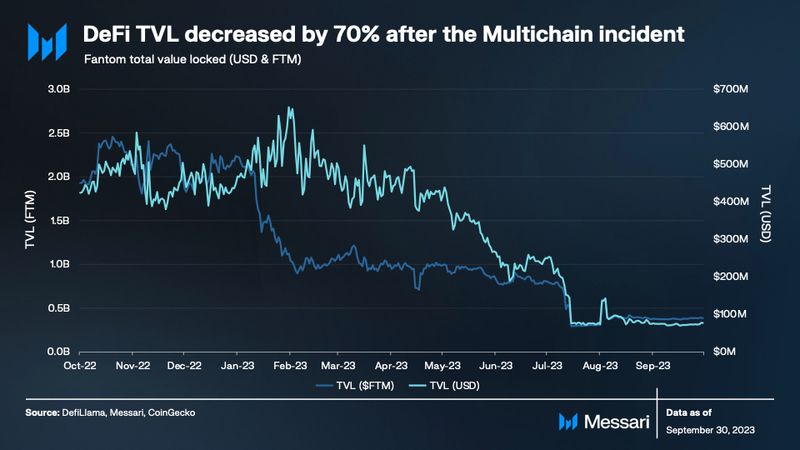
In Q3, Fantom TVL denominated in USD decreased by 69% QoQ to $74.9 million, ranking the network 28th among all chains. However, TVL denominated in FTM decreased by 52%. Part of the decrease in TVL was likely determined by the asset price decreases in USD. In July, the DeFi ecosystem saw a significant decline in TVL due to the Multichain incident. According to Secure3, around $126 million was lost due to the exploit, mainly in wrapped USDT, USDC, WETH, and WBTC. As a result, all Multichain bridged assets were depegged on Fantom’s decentralized exchanges, causing a significant TVL drop. Because of this incident, Geist Finance, a popular lending and borrowing protocol on Fantom, announced that it will be shutting down operations due to the bad debt caused by Multichain assets. The announcement further drove down TVL in Q3’23.
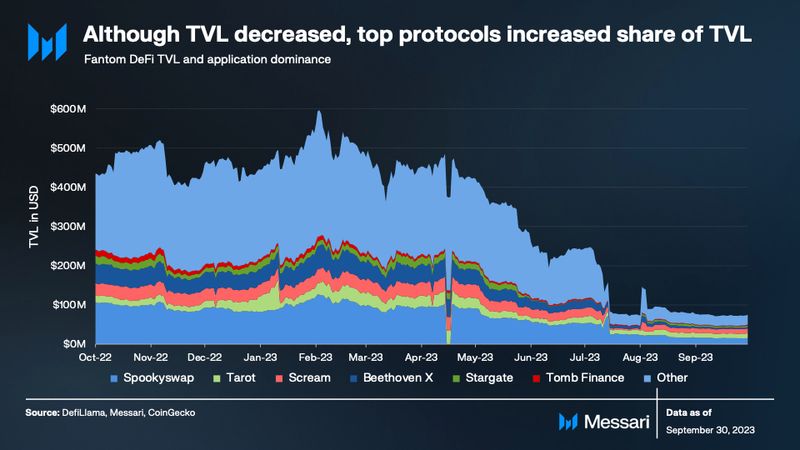
Many of the top DeFi applications on Fantom experienced a downturn in TVL throughout Q3’23. Notable protocols by TVL include SpookySwap (-71%), Tarot (-25%), Scream Finance (-45%), Beethoven X (-80%), and Tomb Finance (-14%). Notably, Stargate Finance increased its TVL QoQ by 293%, from $860,000 to $2.9 million, signaling an increase in third-party bridging volume on Fantom. Furthermore, Stargate Finance introduced additional versions of USDC, USDT, WETH, and WBTC through LayerZero. These lzAssets serve as replacements for the affected Multichain assets that depegged.Despite the decline in TVL, some protocols were able to increase their share of TVL on Fantom, including Tarot (+142%), Scream Finance (+78%), Stargate Finance (+1,173%), and Tomb Finance (+179%). Even with the declines in TVL and issues stemming from Multichain, there was a consistent and healthy distribution of TVL across applications on Fantom. This distribution may have mitigated further damage to the overall DeFi ecosystem. Fantom’s DeFi Diversity Score, which measures the number of protocols that make up the top 90% of TVL, remained flat at 15 QoQ. The continued distribution of TVL on Fantom signals that the DeFi ecosystem is robust enough to manage the risk of TVL concentration in a single application.
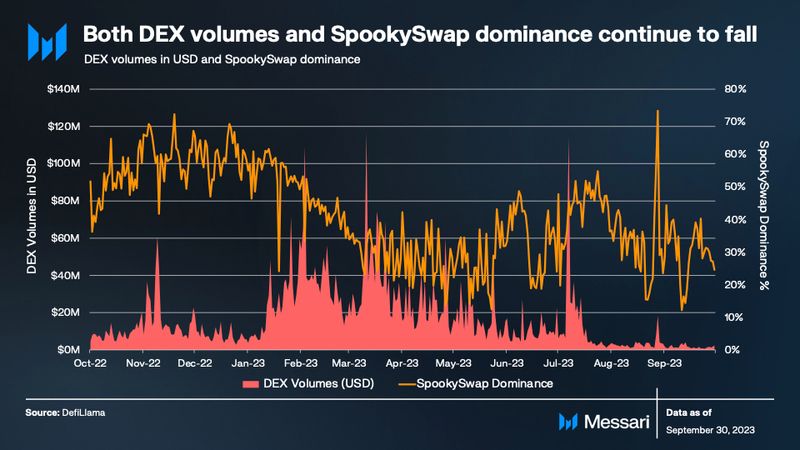
The average daily DEX volume on Fantom decreased by 60% QoQ to $6.7 million. The large spike in DEX volumes in early July was caused by users swapping depegged Multichain assets to non-affected assets such as FTM and MIM. Notably, DEX volumes are down for almost all chains, with the overall DEX volume being at its lowest level since January 2021.Notably, DEXs in the Fantom ecosystem have gotten considerably more competitive throughout 2023. In Q4’22, SpookySwap represented 57% of all DEX trading volumes on Fantom. By Q3’23, SpookySwap’s share had decreased to 41.3% of all DEX volumes. DEXs with over a 10% market share in Q3’23 included Curve Finance (10.5%), Beethoven X (11.2%), and Equalizer (16%).
NFTs, Gaming, and Other
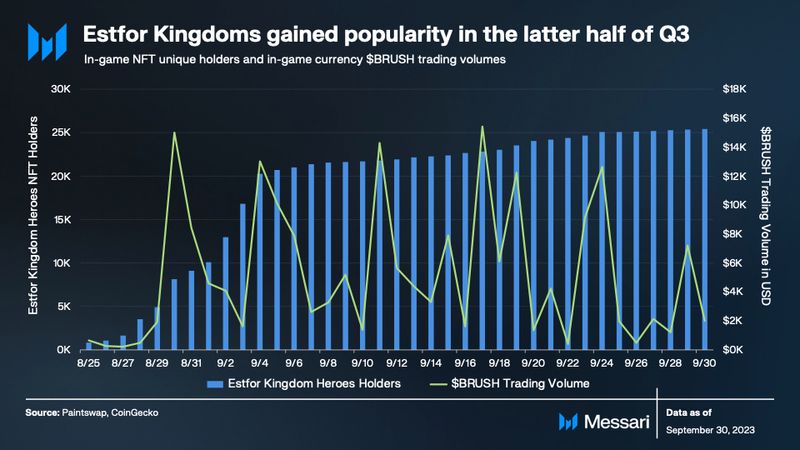
Estfor Kingdom is a multiplayer online role-playing game (MMORPG) that was launched on August 25, 2023, by the PaintSwap development team. Estfor Kingdom is browser-based and utilizes the Fantom blockchain for some of its in-game mechanics. The medieval fantasy game is centered around in-game NFTs called Heroes. Each user can select one of the eight Hero characters and mint it for free. Each individual Hero archetype has unique properties that make it easier to level up certain skillsets. Some skills include Fishing, Cooking, Combat, Alchemy, and more. Additionally, players can level up a Hero’s skills by completing tasks. Furthermore, all in-game items are NFTs and can be traded in the Shop for the in-game currency, BRUSH. Since its launch, Estfor Kingdom has experienced a steadily growing user base. By the end of Q3’23, there were over 25,000 unique wallets with at least one Estfor Kingdom Hero NFT. Trading volumes for the in-game currency BRUSH have also drastically increased, spiking to over $15,000 on some days. Finally, some in-game actions, such as purchases in the Shop, burn 25% of the BRUSH tokens associated with the transaction. Through these burning mechanisms, over 150,000 BRUSH was burned in Q3’23. Additional developments in the NFT space in Q3’23 include:
- Fantom and LayerZero launched a bridging campaign through Galxe that rewards users who bridged at least $100 to Fantom using Stargate Bridge with a holographic NFT. The campaign ends on October 12, 2023.
- Amazon Web Services (AWS) launched a Web3 Development workshop focused on building games on Fantom. The workshop consists of four different modules: (1) Set up the Wallet, (2) Onchain randomness in the Blockchain, (3) Create a Fantasy Game, and (4) Create a Simple UI for your Fantasy Game.
- Mintpad launched on Fantom, allowing users to create NFTs and digital artwork without having developer-level knowledge.
Development

Ecosystem development, measured via the number of unique contracts called and new contracts, has gradually decreased in the past year. The number of unique contracts called throughout the quarter decreased by 16% QoQ to a daily average of 2,706 for Q3’23. The number of new verified contracts deployed in the quarter also decreased, down 36% QoQ to 18.
To help improve the developer experience, Fantom integrated with Add3 in Q3’23. Add3 is an EVM smart contract management platform that has been integrated with multiple EVM-compatible chains. Add3 offers four different products that can now be used on Fantom:
- Add3 Smart Contracts – Streamlined smart contract deployment product that enables developers to greatly reduce the time associated with developing and deploying smart contracts.
- Web3 No-Code Platform – Mainly designed for users without coding experience, this product allows users to deploy smart contracts with no prior coding experience.
- Digital Bond Management – This product allows larger users such as enterprises and governments to better track sensitive data and valuable assets.
- Token Governance – Management of tokens and other cryptoassets, also designed for larger users like enterprises and governments.
With the integration of Add3, Fantom aims to offer a broader suite of options for smart contract development.
Lastly, Fantom was included in Google Cloud’s BigQuery service, alongside 10 other blockchain networks in late September 2023. BitQuery is Google’s data warehouse for blockchain-based data.
Ecosystem Growth Strategy
Fantom has established several growth initiatives in the past year. Namely, Fantom’s recent Ecosystem Vault and Gas Monetization program both continued to build momentum in Q3’23.
One of Fantom’s notable initiatives for 2023 is its Gas Monetization program. This program aims to reward high-quality applications and offer a sustainable income for developers with a portion of the transaction fees they generate.
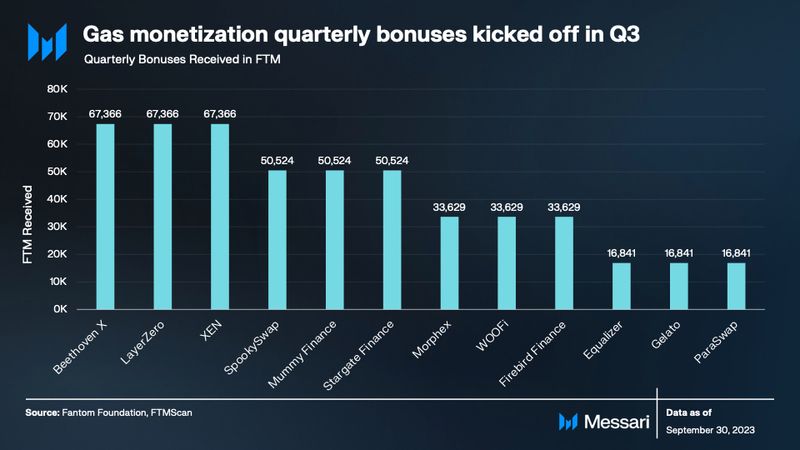
On July 19, 2023, the Fantom Foundation announced the introduction of a quarterly bonus for its Gas Monetization program. To qualify for the program, dApps need to have completed at least 15,000 transactions on Fantom and to have been live on Fantom for at least 1.5 months. Since not all dApps on Fantom can qualify for the Gas Monetization program, a significant portion of FTM (505,000) from transaction fees had accumulated to the program with no clear recipient. To distribute these FTM tokens, the Fantom Foundation decided to distribute them to the top 12 earning projects according to the following split:
- Ranks #1-3: 40% of the FTM
- Ranks #4-6: 30% of the FTM
- Ranks #7-9: 20% of the FTM
- Ranks #10-12: 10% of the FTM
These FTM tokens were distributed in a series of transactions on August 21, 2023. In Q4 2022, the Fantom Foundation launched an Ecosystem Vault on Fantom, which introduced a decentralized funding process to support ecosystem builders. With the initiative, one-third of the 30% transaction fee burn rate (at the time) would be redirected to a Special Fee Contract (SFC). On July 5, 2023, Proposal 37 passed, which will distribute the FTM tokens from the Ecosystem Vault through a Gitcoin Grants program. Gitcoin Grants is a quadratic funding program created by Gitcoin. After community members donate tokens to participating projects in grant rounds, the program matches these donations through a funding allocation method known as quadratic funding. The more unique donations a project receives, the higher the matching funding will be. On August 22, 2023, the Fantom Foundation announced that over 750,000 FTM tokens would be distributed in the first Gitcoin funding round. Projects could apply from August 22-29, 2023, and the eligible recipients were announced on August 30, 2023: DeFi Pool Share, Beethoven X, WigoSwap, Debita, Fantom Lords: Relic Survival, FantomAdventureRPG, Equalizer, PaintSwap & Estfor Kingdom, and Mummy Finance. The 750,000 FTM will be distributed to these projects over a vesting period where 25% is received immediately and the remaining 75% is streamed over six months. The winners of this funding round were announced on October 5, 2023.Lastly, AWS Startups and Covalent co-sponsored the Q2 2023 Fantom Hackathon, which ran from May 8 to July 3, 2023. There were over 1,110 participants, and the prize pool totaled over $300,000. The winners for the hackathon were announced on August 1, 2023, and the top three projects were:
- Heroicus ($10,000) – Heroicus is a cloud server rental program that utilizes NFT technology, specifically the ERC-4907 standard, to represent ownership over a server. Each ERC-4907 NFT has an expiration date attached which represents the end of the rental period.
- Debita ($7,500) – Debita is a P2P lending platform that allows users to lend and borrow cryptoassets without the use of oracles and liquidations. Loans and debts are represented as NFTs, allowing the associated NFT to be traded on secondary markets.
- Fantom Lords: Relic Survivors ($5,500): Fantom Lords is a blockchain-based fantasy game built on Fantom. Users can play the game and compete against one another for weekly prizes.
A full list of projects that received a prize from the hackathon can be found here.
Closing Summary
Following the overall market trend, many of Fantom’s metrics fell QoQ. The Multichain incident in early July partly accelerated this decrease, with average daily transactions and DeFi TVL falling 15% QoQ and 70% QoQ, respectively.
The Gas Monetization program and Ecosystem Vault, both launched in Q4’22, look to reverse these trends by attracting more developers, and thereby users, to the network. Both programs saw success in Q3’23, as the Gas Monetization program distributed over 500,000 FTM ($100,000 as of September 30, 2023) to twelve of the most popular dApps, and the Ecosystem Vault laid the groundwork for distributing 750,000 FTM ($150,000 as of September 30, 2023) through a Gitcoin Grants program.
Many of the Fantom Foundation’s technical efforts have been focused on the recent Fantom Sonic release, which included the FVM and storage system upgrades. Q3’23 revealed some of the preliminary data, which showcased that these upgrades are able to greatly increase the speed and security of the Fantom blockchain. The public testnet for Fantom Sonic recently launched on October 24, 2023. This public testnet hopes to further demonstrate the potential benefits showcased in the private testnet to existing dApps and protocols within the Fantom ecosystem.
All in all, Fantom Foundation’s two-pronged approach of (1) incentivizing third-party developers on Fantom and (2) spearheading technical development puts the protocol on the right track for success in Q4 and beyond, especially in the wake of the Multichain incident.




















